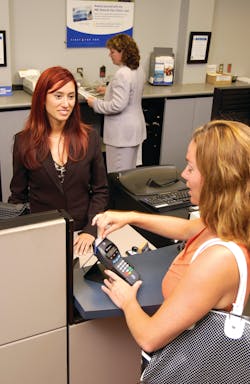Understanding your customer’s needs is a critical requirement in any business, but especially important if you are a security systems integrator selling video surveillance systems to banks and credit unions. While the walk-up nature and location structure of bank branches and facilities tends to be similar to many retail end-users’ needs, there are several differences that should be heeded when selling into this specialized market.
The first thing that’s important to understand about financial institutions is their branch structure. Whether you are selling to a small community bank or a Fortune 500 giant, you will be designing a video surveillance system for multiple physical locations. It could be a few branches in the case of a small community bank, or a tier-one bank with thousands of locations dispersed nationwide.
The Bank Manager isn’t the Security Manager
If you are accustomed to selling video surveillance systems to hotels, factories, hospitals or airports, you can assume that someone at the location will be viewing video, pulling evidence and possibly managing the system; however, in a bank or credit union branch, local staff are unlikely to have any interaction with the video surveillance system. Chances are there will not be anyone onsite viewing live video, searching for archived video or monitoring system health to make sure it is working.
Because no one at the banking branches will likely be tasked with overseeing the system, your customer will need a solution that can be centrally managed by a security team, fraud investigators and IT professionals working at corporate offices dozens or hundreds of miles away. They need the ability to search and retrieve video from any branch, monitor the performance of the system, manage recording parameters and update software remotely as required without leaving their office.
Reliability is another critical requirement in the financial services sector. Holdups, bad checks and ATM fraud can occur at any time and are a huge cost to banks and credit unions, so video evidence must be there when the security team goes looking for it. Presenting a solution with a track record for reliable performance is crucial, but any mechanical device can fail, so a robust health monitoring system that alerts IT staff or security management to a potential hard drive failure or a camera malfunction at a branch is equally important.
Some banks and credit unions may not want to delegate the management of their video surveillance system to the IT team, so solutions that can support optional managed services are a definite advantage. These managed services can be provided by the system vendor or serve as a recurring monthly revenue opportunity for you if you’re willing and able to take on the daily monitoring and health management for the bank.
A Powerful Marriage: Video & Transaction Data
In most cases, banks and credit unions use a video surveillance system to search for and retrieve video in response to a reported incident. For example, a customer receives a monthly statement, sees a series of suspicious ATM withdrawals and calls the bank for assistance. Video evidence of those exact transactions is more than likely available, but the amount of time it takes to find it also impacts the financial institution’s bottom line. This is why more and more banks see value in integrating their ATM and teller transaction data with the video surveillance system. Armed with an integrated video and data solution, the fraud team can simply perform a search based on the customer’s bank card number and then easily click through to the corresponding video. Instead of taking hours to find the required evidence, the investigation could be finished in under a minute.
However, not all incidents of ATM fraud are reported to a financial institution in a timely manner, so banks and credit unions are also looking to their video surveillance systems to proactively alert them to potentially suspicious events, such as ATM skimming and cash harvesting activity.
Catching Losses Proactively
An integrated system with security analytics can flag events such as someone spending more than a set period of time at ATM with no transaction activity, or an individual making multiple withdrawals using different bank cards during one session. The former situation could be indicative of someone installing a skimming device to capture customers’ bank card information and PINs, while the latter might be someone using fraudulent bank cards to steal cash.
Equipped with this capability, fraud investigators can locate and review exact video clips quickly, and then cancel the bank cards, notify customers and provide video evidence to law enforcement proactively if a crime has occurred. Not all banks or credit unions will opt for this capability when initially deploying a solution, but they will want to know it is available so they can upgrade down the road.
We are all well-aware of the current migration to high-definition IP video. Banks and credit unions are like everyone else — they want sharp, crystal-clear video resolution to capture facial images, license plates and bill denominations, but they do not need high-resolution video from each and every camera, and they don’t want to incur the expense of replacing thousands of analog cameras in one fell swoop.
Balancing Investments
If a bank is upgrading its video surveillance system, chances are it will be open to deploying IP cameras at teller stations and ATMs, while continuing to use existing analog cameras in other locations. An all-IP video recorder won’t be the answer because of the need for encoders to accommodate the analog cameras. A hybrid recorder, on the other hand, accommodates both analog and IP cameras — offering maximum flexibility and enabling banking customers to transition to an all-IP deployment economically over time.
For complete scene capture, you may also want to propose a 360-degree IP camera to banking customers. One 360-degree IP camera located strategically in a branch lobby, for example, can replace several analog cameras, and in some circumstances, allow a branch to make do with recorder with fewer video inputs.
The transition to IP video also has implications for storage as well, because higher-resolution video will obviously take up more storage space. The recorder you recommend should be able to store the typical 90 days-worth of video required by financial institutions, and offer disk mirroring to ensure nothing is lost in the event of a hard drive failure.
Time is Money
Another point to bear in mind is serviceability. Even the most reliable video surveillance systems will need maintenance from time to time. What’s important is to be able to detect potential issues, diagnose the problem and get it fixed as soon as possible. Do not try to sell your customer a video recording system that has to be shipped halfway across the country to replace a hard drive or fan. A recorder should be built and designed for easy access, and hard drives, fans and other components should be field replaceable.
Finally, time is money. The last thing a bank or credit union wants is to have a technician show up at a branch and spend hours trying to figure out what’s wrong with a recorder. If the vendor solution you are proposing is leading the way with great training and innovative technical support tools that help your team get a system up and running with a minimum of delay, all the better.
Dan Cremins is director of product management at March Networks, which provides intelligent IP video solutions to more than 450 banks and credit unions worldwide. To request more info about March Networks, please visit www.securityinfowatch.com/10214308.




